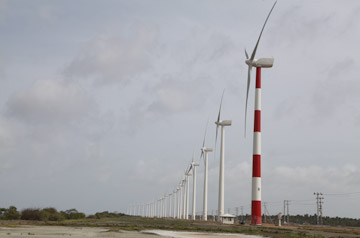In the wake of averting a power crisis, Sri Lanka has also undertaken alternative power generation in addition to hydro power generation. The Puttalam wind farm assists national power generation considerably.
Meanwhile, the Government has implemented several major and small hydro power projects at suitable locations. The Upper Kotmale project takes significance. The Puttalam district is an appropriate location for wind energy.
The wind farms in the Puttalam district adds 50 MW of electricity to the national grid alone, Wind Post Private Limited has invested Rs. 4,000 million on the project, the technical officer of the project, Arjuna Ratnayake said.
Wind farms have been set up in locations where the wind velocity is high. These areas receive less rainfall compared to other parts of the country. Rainfall accompanied by wind in these areas will not affect electricity generation. In the event these areas experience heavy rain, power generation will decline if heavy rains continue. there will be a steady drop in electricity generation, Ratnayake said.
Three wind power plants – the Powerjeng, Nirmalapura and Daily Life Renewable Energy (DLRE) function in various locations in the district under the same company. The project was started in 2011, according to Ratnayake.
He said that Seguwanq and the Widathamuni plants add 20 MW of electricity to the national grid.
There are 12 towers in Seguwanq plant and 13 towers in the Widathamuni plant. The maximum electricity generation capacity from each tower will be 800 kilowatts. There is a general structure to maintain the functioning of the towers and to detect faults, he said.
The increase or drop of power generation depends on wind velocity. The Nirmalapura wind power plant is in Karamba and the Daily life Renewable Energy (DLRE) generate 20 MW of electricity, each 10 MW. he said.
The Wind Post Private Limited also plans to set up a 20 MW electricity generation plant in Elephant-Pass, according to Ratnayake.
In the case of wind power. There is no excess expenditure except for the cost of setting up equipment and the towers. The wind power plants in the Puttalam district contribute to 30 percent said.
During the high wind season, the electricity generation capacity will be high. Electricity generation will be high between May to August and low between September to November.
The shortage will be balanced by excess generation of electricity when the wids are ate high velocity, Ratnayake said.
Although wind power plants have relatively little impact on the environment, compared to fossil fuel power plants, there is some concern over the noise produced by the rotor blades, aesthetic (visual) impacts and birds and bats being killed by flying into the rotors.
Most of these problems have been resolved or greatly reduced through technological development or by proper sitting of wind plants.

